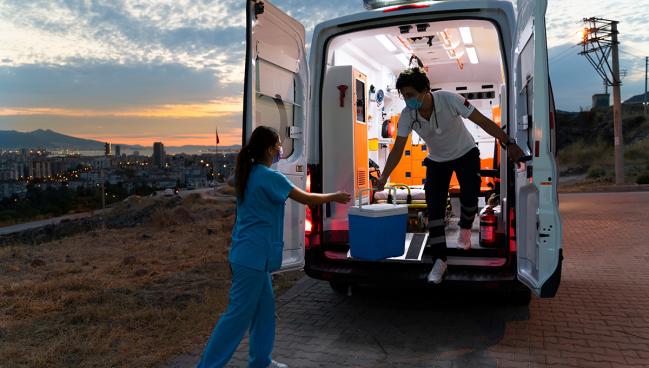Randomized Trial Supports Using Hearts Donated After Circulatory Death
Amid growing interest and evidence, the 6-month findings are good news, but long-term follow-up awaits.

Patients do just as well when they receive a heart donated after circulatory death (DCD) as compared with one donated after brain death (DBD), results from a new randomized trial show.
Six months after transplantation, risk-adjusted survival was similar in the two groups, Jacob Schroder, MD (Duke University Medical Center, Durham, NC), and colleagues report in a paper published recently in the New England Journal of Medicine.
“Until recently, brain-dead donors were the only donors for heart transplantation because brain death permitted in situ assessment of the viability and function of the heart,” they point out. Since 2015, however, advancements in perfusion of donor hearts for transplantation have made it possible to obtain the organs from individuals after circulatory death.
Evidence backing the use of DCD hearts has continued to accrue and the practice is being adopted ever more widely in recent years. But, as of 2020, it still accounted for a minority of all hearts donated in the United States.
Investigator Adam D. DeVore, MD (Duke University Medical Center), said their study is novel by virtue of being randomized, which is rarely done in the heart transplant field. “To really be able to provide the high level of evidence around this question is a big deal, so that we can make sure this is not something that we just offer at large centers like our own but that everyone should feel comfortable adopting this practice,” he told TCTMD.
Longer follow-up will come from the trial itself, at 1 year, and through the mandatory registry that tracks organ transplants in the United States. It also will be important to see whether these results hold up as the procedure starts seeing wider use in less-experienced centers, said DeVore.
What might come as a surprise to clinicians is that use of DCD hearts has expanded the donor pool by 30%, according to their analysis of data from the United Network for Organ Sharing, he said. This progress came with a relatively simple solution, DeVore noted. “These donations are here, their families already want to donate: we just found a way to do it.”
To really be able to provide the high level of evidence around this question is a big deal. Adam D. DeVore
Francisco Arabia Sr, MD (Banner Health, Phoenix, AZ), commenting on the new findings for TCTMD, said the growing literature on DCD hearts underlines its status as a “hot topic,” with study upon study now showing promise. Use of the strategy has enabled the number of transplants to rise nationwide, he noted, which also is reflected in his own center’s experience.
After seeing the procedure done firsthand by another team in 2021, “I thought: this is a really good idea,” said Arabia, who then embarked on creating a registry at Banner University Medical Center. Since February 2022, they have done five such transplants, and last week they shared their results as a poster at the American Society for Artificial Internal Organs meeting in San Francisco, CA. “At least 10% more patients have been able to receive organs using the technique,” he said.
Long-term outcomes aren’t yet known, but up to at least several years after transplant, the outcomes appear to match those of DBD hearts. For recipients, “the operation is the same, the care is the same—everything is the same,” stressed Arabia.
The method is not without controversy, he acknowledged, but among transplant specialists, concerns have been few, since they see the value in having more organs available. “There was discussion in the medical literature, but as time has gone on, it appears that more people are accepting it,” Arabia said, adding that when it comes to wider adoption, only time will tell.
“The important thing is we still need a lot of hearts. The demand is so great compared to the supply,” he added. “Although DCD is making an impact, it might not be enough,” so other potential solutions like xenotransplantation, artificial hearts, or even bioengineered hearts may play a role.
Nancy K. Sweitzer, MD, PhD (Washington University in St. Louis, MO), in an editorial accompanying the NEJM paper, agrees the new findings are an “exciting” confirmation that DCD heart transplantation is both feasible and safe.
“Although caution and continuous evaluation of data are warranted, . . . a safely expanded pool of heart donors has the potential to increase fairness and equity in heart transplantation, allowing more persons with heart failure to have access to this lifesaving therapy. Organ donors and transplantation teams will save increasing numbers of lives with this most precious gift,” she writes.
DCD Heart Trial at 6 Months
For the DCD Heart Trial, participants were drawn from a total of 297 adults awaiting heart transplants at 15 centers in the United States. Researchers randomized them in a 3:1 ratio to two different groups: 1) a heart donated after brain death or 2) a heart donated after the circulatory death of the donor (or donated after brain death, if this organ was available more quickly).
In all, 180 patients underwent transplantation: 90 patients assigned to the DCD group who then did receive a heart through this strategy and 90 who received a DBD heart. Organs obtained after circulatory death were reanimated and assessed using a portable extracorporeal perfusion and preservation system (Organ Care System Heart; TransMedics), whereas those obtained after brain death were preserved using traditional cold storage.
An as-treated analysis—after excluding protocol violations where hearts were donated by minors, the functional warm ischemic time exceeded 30 minutes, or organs were transplanted despite continuously increasing lactate levels—included 166 recipients.
Compared with brain-death donors, those who donated hearts after circulatory death tended to be younger, were more likely to be male, and were more likely to be Black. Recipients of DCD hearts tended to be younger and were more likely to be Black in comparison to those who received DBD organs, and they also were considered to be in more-stable condition prior to transplantation.
Risk-adjusted survival at 6 months, the primary endpoint, was 94% for the DCD group and 90% for the DBD group (P < 0.001).
Rates of serious adverse events associated with the heart graft at 30 days, the primary safety endpoint, were similar overall in the two groups. However, moderate or severe ISHLT primary graft dysfunction was seen more often in those who received a DCD heart compared with a DBD heart (22% vs 10%), as was severe ISHLT primary graft dysfunction (15% vs 5%). Patients given DBD hearts, on the other hand, had a 2.3% rate of primary graft failure resulting in retransplantation, whereas there were no such cases in the DCD group.
At Duke University Medical Center, they’ve been doing DCD heart transplants since 2019, so have had a chance to learn about potential complications with the technique, said DeVore. It’s not surprising to see graft dysfunction with DCD hearts, since these organs go through a little more stress in the donation process compared with DBD hearts. The complication is, in general, an Achilles’ heel of transplantation, but can be managed, he continued.
Moreover, “with the DCD process, it doesn’t really behave the same way: it’s not the same primary graft dysfunction that we’re used to with brain-death donors,” where patients require full mechanical support in the first 24 hours after transplant, he said. A better term here, DeVore suggested, might be “delayed graft function,” because with DCD, “it’s usually just a couple of hours [then] the heart kicks in. It seems like a different beast”—this could explain why it doesn’t appear to have an adverse impact 30 days later.
While the current follow-up in this trial extends to 6 months, there’s no reason to expect DCD outcomes would worsen at a later date, said DeVore.
Hard Decisions
Arabia said that, when it comes to the transplant recipients, what makes them a good candidate doesn’t differ based on whether they receive a heart from a circulatory-death versus brain-death donor. “We offer it to everyone. I would say, 95% of patients will tell us, ‘Sure, I’m okay with this,’” he said.
What’s been more challenging, Arabia added, is finding circulatory-death donors. “These donors are not brain dead yet—they’re not dead. The family decides they’re going to withdraw support because [the patient] has severe brain damage and they’re not going to have quality of life. That’s when we are standing by,” Arabia explained. Five minutes after the donor expires, “then we go in and stabilize the remaining organs.”
But sometimes, despite the withdrawal of support, “the donor doesn’t expire, so the brain is still partially alive. This is very sad, because now you have a person with severe brain damage [and care continues] until another event happens. It’s not only difficult for the family but also for the team that has to travel there, be there, and then come back empty-handed. Then the potential recipient [feels] frustration,” he continued. “So it is what it is. But we are grateful that [more] patients are being transplanted and the outcomes appear to be the same as if we were using the conventional brain-dead donor.”
There are two ways of actually obtaining the organs. One, as described in the NEJM paper, involves removing the heart after circulatory death and then placing it in an extracorporeal perfusion and preservation system and the other, known as normothermic regional perfusion, involves reanimating the heart in the donor’s body after circulatory death but not allowing blood to reenter the brain.
The latter method is somewhat controversial and not all hospitals allow it, Arabia said, though it has been his approach thus far.
As Ashish S. Shah, MD (Vanderbilt University, Nashville, TN), notes in a recently published Circulation article exploring the current state of DCD heart transplantation that “the act of reanimation in situ challenges conventional notions of death. If death begins when the heart stops, what happens if we restart the heart but only to recover organs. This remains a challenging and disturbing concept for many, while others find no hypocrisy or conflict. The family wishes to donate, the reanimation is not intended to resuscitate the dead patient, and scarce and lifesaving organs can be recovered and transplanted.”
This high degree of nuance, as well as other concerns, he says, call for clarity and consensus about how DCD should be carried out.
“First, DCD allows any patient to become a donor,” Shah notes. “Given the potential benefit to another person, the guardrails around surrogate decision-making are critical to protect patients who cannot advocate for themselves.”
Second, there are currently no standards regarding how these donors are managed with analgesia and anesthesia, nor is there a set time among hospitals for how long to wait for them to die after withdrawal of life support. Clinicians should be an “unbiased third party” during this process, he urges. “Hospitals and organ procurement organizations must establish standards on these core phases of passing from a patient to a donor, as inconsistency and miscommunication threaten the public trust regarding organ donation.”
Caitlin E. Cox is News Editor of TCTMD and Associate Director, Editorial Content at the Cardiovascular Research Foundation. She produces the…
Read Full BioSources
Schroder JN, Patel CB, DeVore AD, et al. Transplantation outcomes with donor hearts after circulatory death. N Engl J Med. 2023;388:2121-2131.
Sweitzer NK. Safely increasing heart transplantation with donation after cardiac death. N Engl J Med. 2023;388:2191-2192.
Disclosures
- The study by Schroder et al was funded by TransMedics.
- Schroder and Sweitzer report no relevant conflicts of interest.





Comments